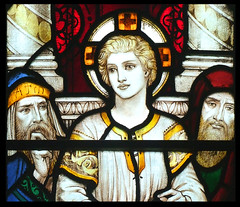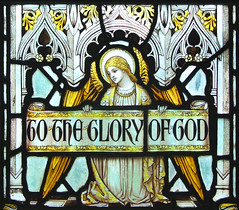| |
|
 |
|
We are up in the
north of the county, on the River
Waveney, which forms the county boundary
with Norfolk. The river winds lazily
through water meadows before gathering
strength and pouring out into the north
sea at Lowestoft. Long before it gets
there it passes through Bungay, and
Bungay is one of East Anglia's loveliest
small towns, the non-identical twin of
the larger and busier Beccles, six miles
down the valley. It actually shares much
of its character with Norfolk towns like
Wymondham, but don't tell anyone in
Bungay this. Like all inhabitants of
border towns, Bungay people are militant
Suffolkers, despite (or perhaps because
of) the fact that the two northern
suburbs of Earsham and Ditchingham
are,whisper it, in Norfolk.
This was an important place in the Middle
Ages. Bungay's strategic position in a
loop of the Waveney meant it became the
site for Hugh Bigod's castle, and it was
the castle which determined the layout of
the modern town. The main shopping street
follows the line of the old defences. On
that side, old fashioned stores, pubs,
hotels. On the other, three churches, two
of them remarkable. The one that isn't
remarkable is this one, Holy Trinity, but
to be fair it is still a grand building,
instantly likeable, full of urban
confidence. |
Bungay and Sudbury were the
only medieval Suffolk towns outside of Bury and
Ipswich to be divided into parishes. Bungay
retained some importance up into the modern era,
the river being navigable to sea-going vessels
until the 1930s, an extraordinary thought when
you see the weed-choked and meandering Waveney
downstream to the east of the town. And of course
for many people Bungay is synonymous with
book-printing, the main town industry until the
start of the 21st Century.
I said elsewhere on this
site that St Peter, Gunton, is the only urban
round-towered church in Suffolk, sitting as it
does within the Lowestoft conurbation.
Technically, I suppose, Bungay is too small to be
considered urban, but Holy Trinity feels like a
civic church, perhaps as a consequence of its
considerable 19th century restoration under the
hands of, firstly, JD Botwright and then Thomas
Jekyll. From
the High Street, you walk through the graveyard
of St Mary, across the road, into that of Holy
Trinity. The round tower greets you here, and so
does Jekyll's castellated porch of 1860. His also
the adjacent stair turret, also castellated. The
tower top had been rebuilt in the 18th century.
One thing you might miss
inside the porch unless you look for it is a
small plaque low down on the door. It says Here
the Fire was Stayed 1688, and commemorates
the great Bungay fire, which gutted and calcified
neighbouring St Mary. Apparently, the door bore
the scorch marks until it was replaced in the
late 19th century. An earlier fire in the 1550s
had destroyed the chancel here, the ruins of it
being cleared away in the early 18th Century. A
new sanctuary was laid out in the 1920s to the
design of F E Howard, the austere triumphalism
typical of that decade and that architect.
Indeed, the whole interior has a feel of the
period. The 1920s and 1930s glass of Powell &
Sons in the south aisle, as you might expect,
fits in perfectly. Happily, Howard left the glass
of the east window clear.
There are a few quirky
curiosities. Glass figures in the north side of
the nave depict the young Christ and the the
young David, with the legend A Thankoffering
from the Infant Sunday School. They are
likely to be contemporary with the building of
the new chancel.
At the west end of
the aisle is one of Suffolk's few 18th
century fonts, not too dissimilar from
the one across the road at St Mary. The
pulpit is a famous example of mid-16th
century work, during the ferment of the
Elizabethan Reformation. A great delight
just to the east of it is the monument to
Thomas and Catherine Wilson by Thomas
Scheemakers, which features a gorgeous
cherub. The church also has a couple of
pre-Reformation brasses - nothing
spectacular, but one is to a former
Prioress of the Priory of God and the
Holy Cross over the way, the ruins of
which survive in the graveyard of St
Mary. There are also a couple of apparent
image niches in the south aisle arcade.
When time comes to leave, follow the
instructions on the south door carefully
- pull the door towards you with your
left hand & twist the latch to your
left with your right hand. Got that?
Like all good civic churches, Holy
Trinity seems to be kept open, an oasis
of peace in a busy little place. Holy
Trinity is not charming, but has a
peaceful elegance about it that will calm
the racing heart; a glass of cold
Sauvignon Blanc perhaps, in contrast to
the exotic cocktail of St
Edmund
around the corner. |
|
 |
|
|
|

